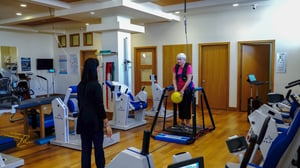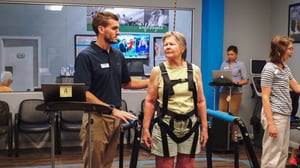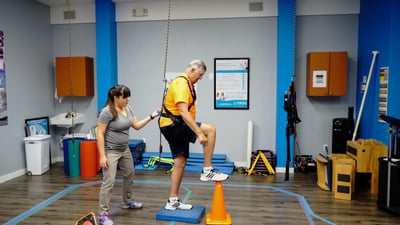Balance & Fall Prevention Services
What is FYZICAL Dizziness & Fall Prevention Center?

As we get older it is common to blame poor balance on aging muscle, but this may not be the only issue. Balance is very complex and relies on our ears, eyes, sensory receptors, and brain. There is a possibility that your balance issue may not be due to the weakening of your muscles. It may be because of a deficiency in your body’s balance mechanism, causing your reflexes to slow. At our FYZICAL Dizziness & Fall Prevention Center, we can diagnose the source of your balance disorder and develop a specialized treatment plan for you to improve your ability to function in activities of everyday living, reduce your risk for falling, and, ultimately, improve your quality of life.
The vestibular system is a main contributor of imbalance and dizziness. This system is in your inner ear and tells the brain where your head is in space. Dizziness from inner ear problems can be treated without medication or surgery through vestibular physical therapy.
What are the different types of dizziness?
Dizziness can be used to describe several distinct sensations.
- Vertigo – Feeling a spinning or whirling sensation.
- Disequilibrium – Feeling like you are tilting, swaying, off-balance or unsteady.
- Light-Headedness/Wooziness – Feeling like you may pass out. Feeling confused.
- Motion Sickness – Feeling queasy or sick to stomach.
- Behavioral – Feeling anxious or panicked.
What are the benefits of balance and gait training?
Balance and gait are inextricably linked because they tend to impact one another. Even if you don’t think you’re in danger of falling over, that running out of steam feeling while walking that you’re attributing to aging muscles could be something else. The problem might actually be slowing reflexes, which make moving around seem more strenuous than it is. By the same token, poor posture and gait can throw off those reflexes.

In fact, the balance and gait systems both rely to some extent on a complex number of body systems that include the inner ear, the eyes, the joint-muscle-nerve system, and of course cognitive functions. Therapy that improves gait and balance works with all of these systems to keep them functioning in harmony.
Gait and balance training has a range of benefits, with avoiding injuries being at the top of the list. Beyond lessening your chances of falling or feeling dizzy, you’re also more likely to feel confident with your footing. In addition, those aches and pains from poor posture are likely to decrease as well.
What does balance and gait training entail?
We'll evaluate your gait to determine potential problems with strength and posture. Simple movements to test balance are also part of the assessment. Together, these basic evaluations point us in the direction of what to focus on in terms of therapy.

Hip and ankle weakness often leads to balance problems, as does poor posture. Strength and flexibility movements can help counteract these problems. These are often as simple as leg lifts while seated in a chair, or “knee marching.” We may also practice standing on one leg, walking heel-to-toe, or tracking the movement of your thumb with your eyes as you move it in various positions.
Our therapists realize how important balance and walking is for independent living, as well as for work activities, exercise, sports and enjoying life in general.
That’s why we provide a range of programs and therapies to evaluate and treat balance disorders:
- Assessment and Evaluation Programs
- Difficulty Walking
- Gait Training and Balance Programs
- Fall Prevention and Balance Retraining
- Manual Therapy
- Fitness and Wellness Programs
- Vestibular Rehab
- Functional Training
Ready to balance your life again?
With our dedicated team of physical therapists behind you, you’ll regain confidence in navigating challenging terrain and learning how to avoid dizzy spells. You may even be able to leave that cane or walker behind!
